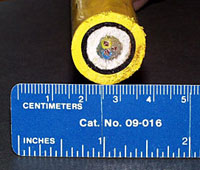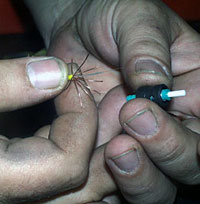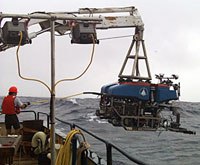Fiber Optics
As you read this Hot Topic, your computer is probably connected to a phone line or an Internet service provider that uses fiber optic cable to transmit the information to you.
Ever wonder how it works? Fiber optic technology was developed in the early 1970s and is rapidly replacing traditional copper cable for transmitting information over hundreds to thousands of miles. Rather than send data in the form of electrons, fiber optic technology uses photons, or light.
Fiber optic cable is made of many thin strands of coated glass fibers. Each measures about eight microns - thats smaller than a strand of human hair. Digitized information is coded, or placed on to light pulses for transmission. It travels along the glass fiber at the speed of light - 186,000 miles per second. When it reaches its destination, a decoder converts the light information into a picture, audio sound or written material in a form we can understand.
It takes two copper wires, like the ones in your telephone cord, to carry just one phone conversation. Fiber optic cable carries much more information than copper cable. Two strands of optical glass fiber can transmit the equivalent of 24,000 telephone calls all at the same time.
Fiber optic cables now cross the worlds oceans to connect many countries together. Whether you are in Mauritius, Australia or the United States, you are probably viewing Dive and Discover at the end of tiny, nearly continuous strands of glass that reach all the way from Woods Hole, Massachusetts to you. To make sure you receive all the information, the fibers are made of ultra-pure glass so that the light pulses are not distorted or weakened.
There are two types of fiber optic cable that allow the light to travel along it in different ways. Today we use single mode fiber that allows the light to follow only one optical path. This makes it possible to transmit much more information over much longer distances.
On board RV Knorr, we use fiber optic cable to connect the different laboratories to the shipboard computer network. But we also use fiber optic cable to connect the ship to ROV Jason while it is underwater. The fiber optic cable we use has three glass strands to send commands to Jason as well as to receive data and images sent from the seafloor back to the ship. Copper wires that send power to Jason surround the three glass strands.
Jason has two fiber optic cables. The main cable runs from the ship to Jason and has steel armor on its outside. This gives it over 20 tons of strength. The other cable is the yellow tether that runs from Medea to Jason. Instead of steel, it is reinforced with a material called Spectra. This material is strong yet light in weight so Jason can move easily without dragging a heavy cable through the water.
Underwater fiber optic cables are used to connect instruments on the seafloor to shore based labs. Scientists can now send commands to their instruments and collect data continuously from their office computer.

Cross section of the fiber optic cable that connects Medea to ROV Jason. The outer yellow and black plastic layers protect it from abrasion. The white material called Spectra provides strength but is very light. The three smaller colored wires in the middle contain the glass strands.

A piece of fiber optic cable unraveled to show the three colored wires containing the glass fibers. The fuzzy white material is the Spectra.

One of the colored wires has been spread out to show the glass fiber. The red arrow points to the junction between the thin glass strand and its outer plastic coating. This protects it from abrasion. The several copper wires surrounding the glass strand are the electrical conductors that carry the 1800 volts used to power ROV Jason. The yellow plastic jacket around the bundle is insulation.

How do you connect two fiber optic cables together? The tip of each glass strand is inserted through a special connector, glued and polished. By placing the polished tips together light can pass from one glass strand to the other. The copper wires on each cable are crimped to make a mechanical connection.

DSOG team member Craig Elder holds the yellow fiber optic tether that connects ROV Jason to Medea.




